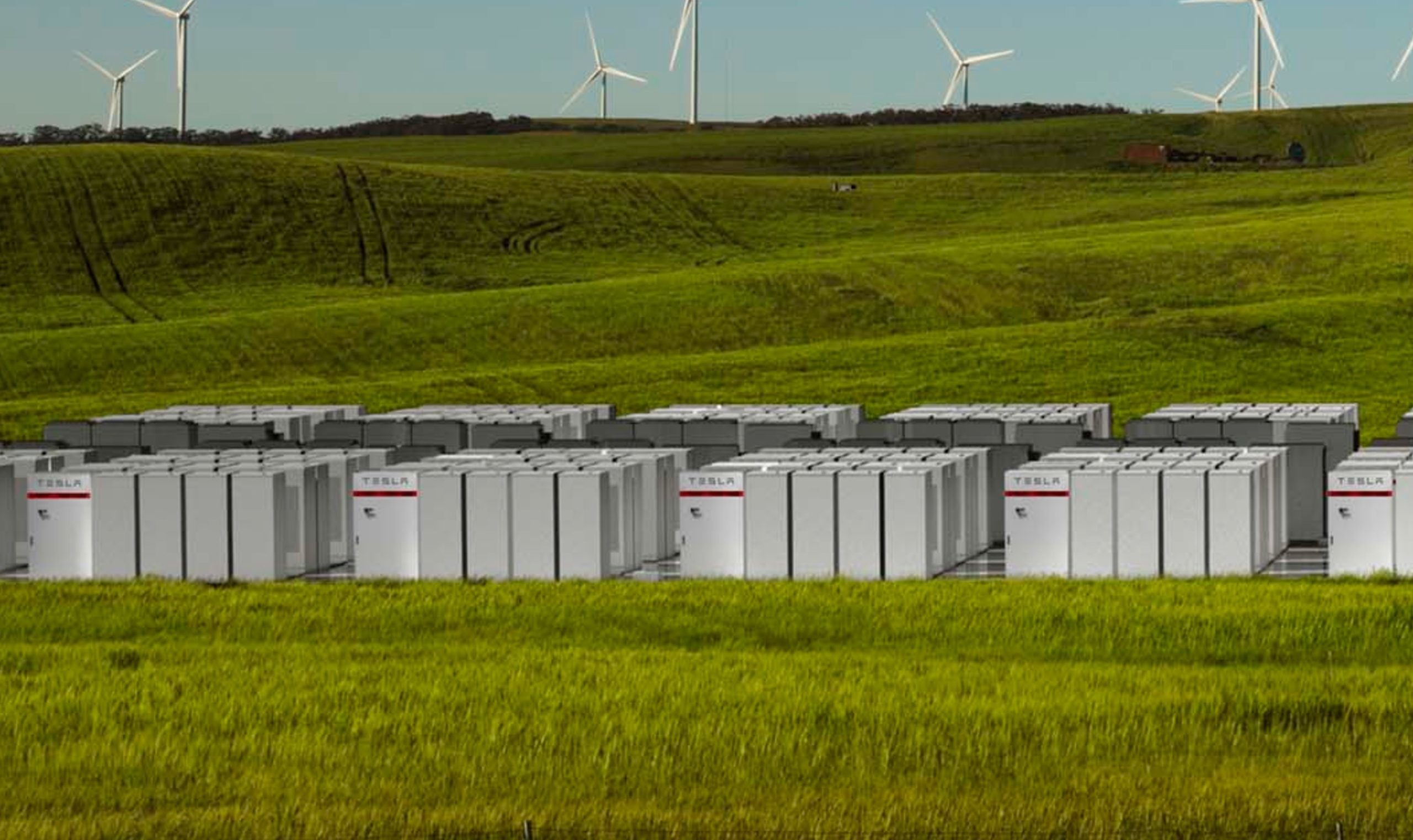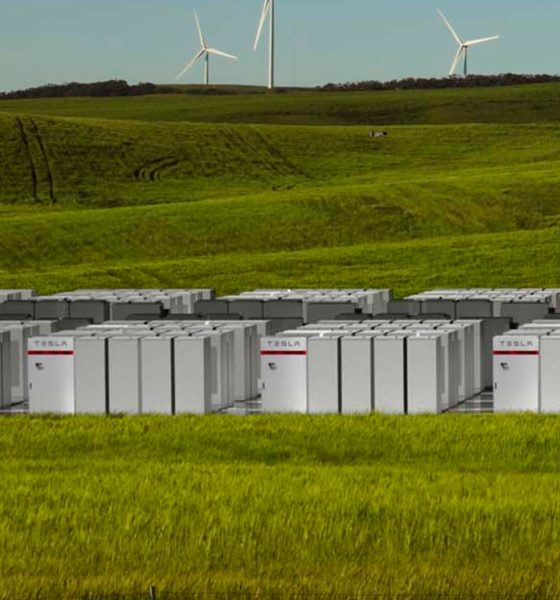

Energy
Tesla says its SA battery response time is too fast for utility billing system
Tesla’s 100 MW/129MWh Powerpack system near Jamestown in South Australia is proving to be so quick in providing backup power to the energy grid that 30-40% of the services it provides end up unpaid. The electric car and energy company claims that this is due to SA’s legacy utility billing system not being optimized for the big battery’s response time.
Tesla’s earnings from its big battery installation currently follow the standards set by the Australian Energy Market Operator (AEMO), which breaks down a power provider’s response time into 6 seconds, 1 minute, and 5 minutes for energy to be fed into the grid. Tesla’s SA Powerpack farm near Jamestown, however, has been providing backup energy in as quick as 200 milliseconds. Thus, any amount of energy sent from Tesla’s battery into the grid that lasts between 200 milliseconds and 6 seconds is just too quick to be registered according to AEMO’s current specifications.
In a statement to The Sydney Morning Herald, Tesla stated that around 30%-40% of services provided by the SA big battery ended up unpaid due to the system’s quick response time. Tesla further asserted that AEMO’s standards are currently designed for fossil fuel-based backup systems, which respond to energy grid instabilities far slower than the industry-grade Powerpack batteries.
“Tesla estimates that the Hornsdale Power Reserve battery has delivered 30 to 40% of its services to frequency markets without being paid due to existing AEMO technical specifications being written based on fossil fuel generation assets.
“Current standards compensate batteries for their capacity based on fossil generator response rates, despite the ability to provide a faster ramp time. This makes it difficult for the full value of fast-responding technologies to be recognized in the current contingency FCAS markets.”
Over the past few months, Tesla’s SA Powerpack farm, which currently stands as the largest lithium-ion battery installation in the world, has been pivotal in stabilizing the energy grid in South Australia. Last December alone, Tesla’s 100 MW/129MWh installation accomplished a huge feat, keeping the region’s energy stable amidst the unexpected failure of the coal-powered Loy Yang A power plant in Victoria. During that time, Tesla’s Powerpacks backed up the grid within 0.14 seconds after the unexpected breakdown of the coal-powered plant. The system also supported the grid hundreds of times over the course of the month.
The performance of Tesla’s big battery in South Australia was recently examined by energy expert Hugh Saddler, who studied the charge and discharge patterns of the installation. Over the course of his tests, Saddler noted that the Powerpack farm exhibited great efficiency, with 30% of the battery’s 100MW capacity being allocated to the system’s daily charge and discharge cycles, and the rest being allotted to keep the energy grid’s frequency at a steady 50 Hz and 240 volts.
Tesla’s energy initiatives in South Australia recently met a series of roadblocks, however, with South Australia resource minister Matt Canavan mocking the SA Powerpack farm by calling it the “Kardashian” of the energy industry and alleging that the installation is simply “famous for being famous.” Newly-elected South Australia premier Steven Marshall has also gone on the offensive against the Elon Musk-led company’s projects, stating that his government would not be supporting Tesla’s proposal of building a 250 MW/650 MWh virtual power plant from 50,000 low-income residential units and home Powerwall 2 systems.

Cybertruck
Tesla updates Cybertruck owners about key Powershare feature

Tesla is updating Cybertruck owners on its timeline of a massive feature that has yet to ship: Powershare with Powerwall.
Powershare is a bidirectional charging feature exclusive to Cybertruck, which allows the vehicle’s battery to act as a portable power source for homes, appliances, tools, other EVs, and more. It was announced in late 2023 as part of Tesla’s push into vehicle-to-everything energy sharing, and acting as a giant portable charger is the main advantage, as it can provide backup power during outages.
Cybertruck’s Powershare system supports both vehicle-to-load (V2L) and vehicle-to-home (V2H), making it flexible and well-rounded for a variety of applications.
However, even though the feature was promised with Cybertruck, it has yet to be shipped to vehicles. Tesla communicated with owners through email recently regarding Powershare with Powerwall, which essentially has the pickup act as an extended battery.
Powerwall discharge would be prioritized before tapping into the truck’s larger pack.
However, Tesla is still working on getting the feature out to owners, an email said:
“We’re writing to let you know that the Powershare with Powerwall feature is still in development and is now scheduled for release in mid-2026.
This new release date gives us additional time to design and test this feature, ensuring its ability to communicate and optimize energy sharing between your vehicle and many configurations and generations of Powerwall. We are also using this time to develop additional Powershare features that will help us continue to accelerate the world’s transition to sustainable energy.”
Owners have expressed some real disappointment in Tesla’s continuous delays in releasing the feature, as it was expected to be released by late 2024, but now has been pushed back several times to mid-2026, according to the email.
Foundation Series Cybertruck buyers paid extra, expecting the feature to be rolled out with their vehicle upon pickup.
Cybertruck’s Lead Engineer, Wes Morrill, even commented on the holdup:
As a Cybertruck owner who also has Powerwall, I empathize with the disappointed comments.
To their credit, the team has delivered powershare functionality to Cybertruck customers who otherwise have no backup with development of the powershare gateway. As well as those with solar…
— Wes (@wmorrill3) December 12, 2025
He said that “it turned out to be much harder than anticipated to make powershare work seamlessly with existing Powerwalls through existing wall connectors. Two grid-forming devices need to negotiate who will form and who will follow, depending on the state of charge of each, and they need to do this without a network and through multiple generations of hardware, and test and validate this process through rigorous certifications to ensure grid safety.”
It’s nice to see the transparency, but it is justified for some Cybertruck owners to feel like they’ve been bait-and-switched.
Energy
Tesla starts hiring efforts for Texas Megafactory
Tesla’s Brookshire site is expected to produce 10,000 Megapacks annually, equal to 40 gigawatt hours of energy storage.

Tesla has officially begun hiring for its new $200 million Megafactory in Brookshire, Texas, a manufacturing hub expected to employ 1,500 people by 2028. The facility, which will build Tesla’s grid-scale Megapack batteries, is part of the company’s growing energy storage footprint.
Tesla’s hiring efforts for the Texas Megafactory are hinted at by the job openings currently active on the company’s Careers website.
Tesla’s Texas Megafactory
Tesla’s Brookshire site is expected to produce 10,000 Megapacks annually, equal to 40 gigawatt hours of energy storage, similar to the Lathrop Megafactory in California. Tesla’s Careers website currently lists over 30 job openings for the site, from engineers, welders, and project managers. Each of the openings is listed for Brookshire, Texas.
The company has leased two buildings in Empire West Business Park, with over $194 million in combined property and equipment investment. Tesla’s agreement with Waller County includes a 60% property tax abatement, contingent on meeting employment benchmarks: 375 jobs by 2026, 750 by 2027, and 1,500 by 2028, as noted in a report from the Houston Business Journal. Tesla is required to employ at least 1,500 workers in the facility through the rest of the 10-year abatement period.
Tesla’s clean energy boom
City officials have stated that Tesla’s arrival marks a turning point for the Texas city, as it highlights a shift from logistics to advanced clean energy manufacturing. Ramiro Bautista from Brookshire’s economic development office, highlighted this in a comment to the Journal.
“(Tesla) has great-paying jobs. Not just that, but the advanced manufacturing (and) clean energy is coming to the area,” he said. “So it’s not just your normal logistics manufacturing. This is advanced manufacturing coming to this area, and this brings a different type of job and investment into the local economy.”
Energy
Tesla and Samsung SDI in talks over new US battery storage deal: report
The update was related by industry sources and initially reported by South Korean news outlets.

Recent reports have suggested that Tesla and Samsung SDI are in talks over a potential partnership to supply batteries for large-scale energy storage systems (ESS).
The update was related by industry sources and initially reported by South Korean news outlets.
ESS batteries to be built at Samsung’s Indiana plant
As noted in a report from Korea JoongAng Daily, the demand for energy storage systems has been growing rapidly in North America, thanks in no small part to the surge in AI investments across numerous companies. With this in mind, Tesla has reportedly approached Samsung SDI about a potential battery supply deal.
The deal is reportedly worth over 3 trillion Korean won (approximately $2.11 billion) and will span three years, according to The Korea Global Economic Daily. A battery supply deal with Samsung SDI could make sense for Tesla as the company already has a grid-scale battery, the Megapack, which is perfect for industrial use. Samsung SDI could simply supply cells for the EV maker.
Production of the batteries would reportedly take place at Samsung SDI’s joint venture factory with Stellantis in Indiana, which is currently under construction. Samsung SDI recently announced plans to use part of that plant’s EV lines to produce cells for ESS, with a targeted capacity of 30 GWh by the end of next year.
Tesla and Samsung’s partnership
At present, only a handful of manufacturers, including Korea’s LG Energy Solution, Samsung SDI, SK On, and Japan’s Panasonic, are capable of producing energy storage-scale batteries domestically in the United States. A Samsung SDI official issued a comment about the matter, stating, “Nothing has been finalized regarding cooperation with Tesla.”
The possible energy storage system deal adds another layer to Tesla’s growing collaboration with Samsung, which is already in line as a partner in the upcoming production of Tesla’s AI5 and AI6 chips. Early sample manufacturing of the AI6 is expected to begin in South Korea, with mass production slated for Samsung’s Texas-based Taylor foundry when it starts operations.
The AI6 chip will power Tesla’s next wave of high-volume projects, including the Optimus humanoid robot and the autonomous Cybercab service. Musk has called the partnership with Samsung a “real collaboration,” adding that he personally plans to “walk the line” at the Taylor facility to speed up progress.









